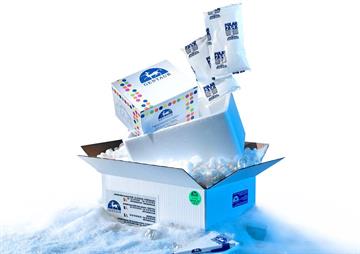Anti-Human NRP-1 Antibody

Anti-Human NRP-1 Antibody
457.12 EUR
In Stock
quantity
Produktdetaljer
Katalognummer: 209 - 102-PA23
Produktkategori: Företag och industri > Vetenskap och laboratorium
ReliaTechGentaur
Storlek: 200 µg
Related Products
102-PA23
Anti-Human NRP-1 Antibody
Neuropilin-1 (NRP-1, CD304) is a 130-140 kDa type I transmembrane glycoprotein that regulates axon guidance and angiogenesis. The human NRP-1 contains a 623 aa extracellular domain (ECD) that shows 92-95% aa identity with mouse, rat, bovine and canine NRP-1. The ECD contains two N-terminal CUB domains (termed a1a2), two domains with homology to coagulation factors V and VIII (b1b2) and a MAM (meprin) domain. C-terminally divergent splice variants with 704, 644, 609, and 551 aa lack the MAM and TM domains and are demonstrated or presumed to be soluble antagonists. Heparin, the heparin-binding forms of VEGF (VEGF165, VEGF-B; VEGF-E), PlGF-2, and the C-terminus of Sema3 bind the b1b2 region. NRP-1 and NRP-2 share 48% aa identity within the ECD and can form homo and hetero-oligomers via interaction of their MAM domains. Neuropilins show partially overlapping expression in neuronal and endothelial cells during development. Both neuropilins act as coreceptors with Plexins, mainly Plexin A3 and A4, to bind class III Semaphorins that mediate axon repulsion. However, only NRP-1 binds Sema3A, and only NRP-2 binds Sema 3F. Both are co-receptors with VEGFR-2 (KDR7Flk1) for VEGF165 binding. Sema 3A signaling can be blocked by VEGF165, which has higher affinity for NRP-1. NRP-1 is preferentially expressed in arteries during development or those undergoing remodeling. NRP-1 is also expressed on dendritic cells and mediates DC-induced T-cell proliferation
457.12 €
102-PA23AG
Anti-Human NRP-1 Antibody
Neuropilin-1 (NRP-1, CD304) is a 130-140 kDa type I transmembrane glycoprotein that regulates axon guidance and angiogenesis. The human NRP-1 contains a 623 aa extracellular domain (ECD) that shows 92-95% aa identity with mouse, rat, bovine and canine NRP-1. The ECD contains two N-terminal CUB domains (termed a1a2), two domains with homology to coagulation factors V and VIII (b1b2) and a MAM (meprin) domain. C-terminally divergent splice variants with 704, 644, 609, and 551 aa lack the MAM and TM domains and are demonstrated or presumed to be soluble antagonists. Heparin, the heparin-binding forms of VEGF (VEGF165, VEGF-B; VEGF-E), PlGF-2, and the C-terminus of Sema3 bind the b1b2 region. NRP-1 and NRP-2 share 48% aa identity within the ECD and can form homo and hetero-oligomers via interaction of their MAM domains. Neuropilins show partially overlapping expression in neuronal and endothelial cells during development. Both neuropilins act as coreceptors with Plexins, mainly Plexin A3 and A4, to bind class III Semaphorins that mediate axon repulsion. However, only NRP-1 binds Sema3A, and only NRP-2 binds Sema 3F. Both are co-receptors with VEGFR-2 (KDR7Flk1) for VEGF165 binding. Sema 3A signaling can be blocked by VEGF165, which has higher affinity for NRP-1. NRP-1 is preferentially expressed in arteries during development or those undergoing remodeling. NRP-1 is also expressed on dendritic cells and mediates DC-induced T-cell proliferation
386.25 €
102-PA23S
Anti-Human NRP-1 Antibody
Neuropilin-1 (NRP-1, CD304) is a 130-140 kDa type I transmembrane glycoprotein that regulates axon guidance and angiogenesis. The human NRP-1 contains a 623 aa extracellular domain (ECD) that shows 92-95% aa identity with mouse, rat, bovine and canine NRP-1. The ECD contains two N-terminal CUB domains (termed a1a2), two domains with homology to coagulation factors V and VIII (b1b2) and a MAM (meprin) domain. C-terminally divergent splice variants with 704, 644, 609, and 551 aa lack the MAM and TM domains and are demonstrated or presumed to be soluble antagonists. Heparin, the heparin-binding forms of VEGF (VEGF165, VEGF-B; VEGF-E), PlGF-2, and the C-terminus of Sema3 bind the b1b2 region. NRP-1 and NRP-2 share 48% aa identity within the ECD and can form homo and hetero-oligomers via interaction of their MAM domains. Neuropilins show partially overlapping expression in neuronal and endothelial cells during development. Both neuropilins act as coreceptors with Plexins, mainly Plexin A3 and A4, to bind class III Semaphorins that mediate axon repulsion. However, only NRP-1 binds Sema3A, and only NRP-2 binds Sema 3F. Both are co-receptors with VEGFR-2 (KDR7Flk1) for VEGF165 binding. Sema 3A signaling can be blocked by VEGF165, which has higher affinity for NRP-1. NRP-1 is preferentially expressed in arteries during development or those undergoing remodeling. NRP-1 is also expressed on dendritic cells and mediates DC-induced T-cell proliferation
339 €
Håll dig uppdaterad! Visa tidigare publikationer

By: Author , 2 Comment
Anaplasmos hos hundar och katter – allt du behöver veta
23 August 2025

By: Author , 2 Comment
Solbränna – hur leker man säkert i solen?
16 August 2025

By: Author , 2 Comment
Biologiska läkemedel – Modernitet inom farmaci
1 August 2025

By: Author , 2 Comment
Icke-steroida antiinflammatoriska läkemedel – viktig information om populära läkemedel
22 July 2025








